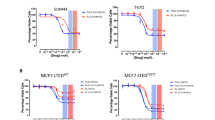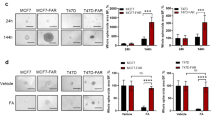Abstract
ErbB3, a member of the ErbB family of receptor tyrosine kinases, is a potent activator of phosphatidyl inositol-3 kinase (PI3K) and mammalian target of rapamycin (mTOR) signaling, driving tumor cell survival and therapeutic resistance in breast cancers. In luminal breast cancers, ErbB3 upregulation following treatment with the antiestrogen fulvestrant enhances PI3K/mTOR-mediated cell survival. However, the mechanism by which ErbB3 is upregulated in fulvestrant-treated cells is unknown. We found that ErbB3 protein levels and cell surface presentation were increased following fulvestrant treatment, focusing our attention on proteins that regulate ErbB3 at the cell surface, including Nrdp1, NEDD4 and LRIG1. Among these, only LRIG1 correlated positively with ERα, but inversely with ErbB3 in clinical breast cancer data sets. LRIG1, an estrogen-inducible ErbB downregulator, was decreased in a panel of fulvestrant-treated luminal breast cancer cells. Ectopic LRIG1 expression from an estrogen-independent promoter uncoupled LRIG1 from estrogen regulation, thus sustaining LRIG1 and maintaining low ErbB3 levels in fulvestrant-treated cells. An LRIG1 mutant lacking the ErbB3 interaction motif was insufficient to downregulate ErbB3. Importantly, LRIG1 overexpression improved fulvestrant-mediated growth inhibition, whereas cells expressing the LRIG1 mutant were poorly sensitive to fulvestrant, despite effective ERα downregulation. Consistent with these results, LRIG1 expression correlated positively with increased disease-free survival in antiestrogen-treated breast cancer patients. These data suggest that ERα-dependent expression of LRIG1 dampens ErbB3 signaling in luminal breast cancer cells, and by blocking ERα activity with fulvestrant, LRIG1 is decreased thus permitting ErbB3 accumulation, enhanced ErbB3 signaling to cell survival pathways and blunting therapeutic response to fulvestrant.
This is a preview of subscription content, access via your institution
Access options
Subscribe to this journal
Receive 50 print issues and online access
$259.00 per year
only $5.18 per issue
Buy this article
- Purchase on Springer Link
- Instant access to full article PDF
Prices may be subject to local taxes which are calculated during checkout






Similar content being viewed by others
Change history
03 March 2016
This article has been corrected since Advance Online Publication and a corrigendum is also printed in this issue.
References
Stern DF . ERBB3/HER3 and ERBB2/HER2 duet in mammary development and breast cancer. J Mammary Gland Biol Neoplasia 2008; 13: 215–223.
Morrison MM, Hutchinson K, Williams MM, Stanford JC, Balko JM, Young C et al. ErbB3 downregulation enhances luminal breast tumor response to antiestrogens. J Clin Invest 2013; 123: 4329–4343.
Hutcheson IR, Goddard L, Barrow D, McClelland RA, Francies HE, Knowlden JM et al. Fulvestrant-induced expression of ErbB3 and ErbB4 receptors sensitizes oestrogen receptor-positive breast cancer cells to heregulin beta1. Breast Cancer Res 2011; 13: R29.
Tovey S, Dunne B, Witton CJ, Forsyth A, Cooke TG, Bartlett JM . Can molecular markers predict when to implement treatment with aromatase inhibitors in invasive breast cancer? Clin Cancer Res 2005; 11: 4835–4842.
Liu B, Ordonez-Ercan D, Fan Z, Edgerton SM, Yang X, Thor AD . Downregulation of erbB3 abrogates erbB2-mediated tamoxifen resistance in breast cancer cells. Int J Cancer 2007; 120: 1874–1882.
Kraus MH, Issing W, Miki T, Popescu NC, Aaronson SA . Isolation and characterization of ERBB3, a third member of the ERBB/epidermal growth factor receptor family: evidence for overexpression in a subset of human mammary tumors. Proc Natl Acad Sci USA 1989; 86: 9193–9197.
Kim HH, Vijapurkar U, Hellyer NJ, Bravo D, Koland JG . Signal transduction by epidermal growth factor and heregulin via the kinase-deficient ErbB3 protein. Biochem J 1998; 334: 189–195.
Hamburger AW . The role of ErbB3 and its binding partners in breast cancer progression and resistance to hormone and tyrosine kinase directed therapies. J Mammary Gland Biol Neoplasia 2008; 13: 225–233.
Sutherland RL . Endocrine resistance in breast cancer: new roles for ErbB3 and ErbB4. Breast Cancer Res 2011; 13: 106.
Hellyer NJ, Cheng K, Koland JG . ErbB3 (HER3) interaction with the p85 regulatory subunit of phosphoinositide 3-kinase. Biochem J 1998; 333: 757–763.
Kim HH, Sierke SL, Koland JG . Epidermal growth factor-dependent association of phosphatidylinositol 3-kinase with the erbB3 gene product. J Biol Chem 1994; 269: 24747–24755.
Klempner SJ, Myers AP, Cantley LC . What a tangled web we weave: emerging resistance mechanisms to inhibition of the phosphoinositide 3-kinase pathway. Cancer Discov 2013; 3: 1345–1354.
Wong KK, Engelman JA, Cantley LC . Targeting the PI3K signaling pathway in cancer. Curr Opin Genet Dev 2010; 20: 87–90.
Aurisicchio L, Marra E, Luberto L, Carlomosti F, De Vitis C, Noto A et al. Novel anti-ErbB3 monoclonal antibodies show therapeutic efficacy in xenografted and spontaneous mouse tumors. J Cell Physiol 2012; 227: 3381–3388.
Belleudi F, Marra E, Mazzetta F, Fattore L, Giovagnoli MR, Mancini R et al. Monoclonal antibody-induced ErbB3 receptor internalization and degradation inhibits growth and migration of human melanoma cells. Cell Cycle 2012; 11: 1455–1467.
Ali S, Metzger D, Bornert JM, Chambon P . Modulation of transcriptional activation by ligand-dependent phosphorylation of the human oestrogen receptor A/B region. EMBO J 1993; 12: 1153–1160.
Laederich MB, Funes-Duran M, Yen L, Ingalla E, Wu X, Carraway KL 3rd et al. The leucine-rich repeat protein LRIG1 is a negative regulator of ErbB family receptor tyrosine kinases. J Biol Chem 2004; 279: 47050–47056.
Diamonti AJ, Guy PM, Ivanof C, Wong K, Sweeney C, Carraway KL 3rd . An RBCC protein implicated in maintenance of steady-state neuregulin receptor levels. Proc Natl Acad Sci USA 2002; 99: 2866–2871.
Qiu XB, Goldberg AL . Nrdp1/FLRF is a ubiquitin ligase promoting ubiquitination and degradation of the epidermal growth factor receptor family member, ErbB3. Proc Natl Acad Sci USA 2002; 99: 14843–14848.
Huang Z, Choi BK, Mujoo K, Fan X, Fa M, Mukherjee S et al. The E3 ubiquitin ligase NEDD4 negatively regulates HER3/ErbB3 level and signaling. Oncogene 2014; 34: 1105–1115.
Rafidi H, Mercado F 3rd, Astudillo M, Fry WH, Saldana M, Carraway KL 3rd et al. Leucine-rich repeat and immunoglobulin domain-containing protein-1 (Lrig1) negative regulatory action toward ErbB receptor tyrosine kinases is opposed by leucine-rich repeat and immunoglobulin domain-containing protein 3 (Lrig3). J Biol Chem 2013; 288: 21593–21605.
Krig SR, Frietze S, Simion C, Miller JK, Fry WH, Rafidi H et al. Lrig1 is an estrogen-regulated growth suppressor and correlates with longer relapse-free survival in ERalpha-positive breast cancer. Mol Cancer Res 2011; 9: 1406–1417.
Miller JK, Shattuck DL, Ingalla EQ, Yen L, Borowsky AD, Young LJ et al. Suppression of the negative regulator LRIG1 contributes to ErbB2 overexpression in breast cancer. Cancer Res 2008; 68: 8286–8294.
Shattuck DL, Miller JK, Laederich M, Funes M, Petersen H, Carraway KL 3rd et al. LRIG1 is a novel negative regulator of the Met receptor and opposes Met and Her2 synergy. Mol Cell Biol 2007; 27: 1934–1946.
Stutz MA, Shattuck DL, Laederich MB, Carraway KL 3rd, Sweeney C . LRIG1 negatively regulates the oncogenic EGF receptor mutant EGFRvIII. Oncogene 2008; 27: 5741–5752.
Balko JM, Miller TW, Morrison MM, Hutchinson K, Young C, Rinehart C et al. The receptor tyrosine kinase ErbB3 maintains the balance between luminal and basal breast epithelium. Proc Natl Acad Sci USA 2012; 109: 221–226.
Cook RS, Garrett JT, Sanchez V, Stanford JC, Young C, Chakrabarty A et al. ErbB3 ablation impairs PI3K/Akt-dependent mammary tumorigenesis. Cancer Res 2011; 71: 3941–3951.
Ghasimi S, Haapasalo H, Eray M, Korhonen K, Brannstrom T, Hedman H et al. Immunohistochemical analysis of LRIG proteins in meningiomas: correlation between estrogen receptor status and LRIG expression. J Neurooncol 2012; 108: 435–441.
Wong VW, Stange DE, Page ME, Buczacki S, Wabik A, Itami S et al. Lrig1 controls intestinal stem-cell homeostasis by negative regulation of ErbB signalling. Nat Cell Biol 2012; 14: 401–408.
Wiseman SM, Makretsov N, Nielsen TO, Gilks B, Yorida E, Cheang M et al. Coexpression of the type 1 growth factor receptor family members HER-1, HER-2, and HER-3 has a synergistic negative prognostic effect on breast carcinoma survival. Cancer 2005; 103: 1770–1777.
Sundvall M, Iljin K, Kilpinen S, Sara H, Kallioniemi OP, Elenius K . Role of ErbB4 in breast cancer. J Mammary Gland Biol Neoplasia 2008; 13: 259–268.
Fattore L, Marra E, Pisanu ME, Noto A, de Vitis C, Belleudi F et al. Activation of an early feedback survival loop involving phospho-ErbB3 is a general response of melanoma cells to RAF/MEK inhibition and is abrogated by anti-ErbB3 antibodies. J Transl Med 2013; 11: 180.
Noto A, De Vitis C, Roscilli G, Fattore L, Malpicci D, Marra E et al. Combination therapy with anti-ErbB3 monoclonal antibodies and EGFR TKIs potently inhibits non-small cell lung cancer. Oncotarget 2013; 4: 1253–1265.
Baselga J, Campone M, Piccart M, Burris HA 3rd, Rugo HS, Sahmoud T et al. Everolimus in postmenopausal hormone-receptor-positive advanced breast cancer. N Engl J Med 2012; 366: 520–529.
Comprehensive molecular portraits of human breast tumours. Nature. [Research Support, N.I.H., Extramural Research Support, Non-U.S. Gov't Research Support, U.S. Gov't, Non-P.H.S.] 2012; 490: 61–70.
Cerami E, Gao J, Dogrusoz U, Gross BE, Sumer SO, Aksoy BA et al. The cBio cancer genomics portal: an open platform for exploring multidimensional cancer genomics data. Cancer Discov 2012; 2: 401–404.
Acknowledgements
This work was supported by the National Institutes of Health R01CA143126 (RSC) and Susan G. Komen for the Cure grant KG100677 (RSC).
Author information
Authors and Affiliations
Corresponding author
Ethics declarations
Competing interests
The authors declare no conflict of interest.
Additional information
Supplementary Information accompanies this paper on the Oncogene website
Supplementary information
Rights and permissions
About this article
Cite this article
Morrison, M., Williams, M., Vaught, D. et al. Decreased LRIG1 in fulvestrant-treated luminal breast cancer cells permits ErbB3 upregulation and increased growth. Oncogene 35, 1143–1152 (2016). https://doi.org/10.1038/onc.2015.169
Received:
Revised:
Accepted:
Published:
Issue Date:
DOI: https://doi.org/10.1038/onc.2015.169
This article is cited by
-
LRIG1 is a pleiotropic androgen receptor-regulated feedback tumor suppressor in prostate cancer
Nature Communications (2019)



